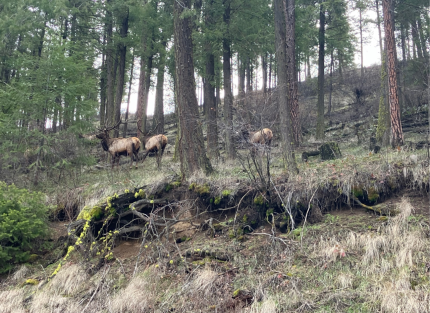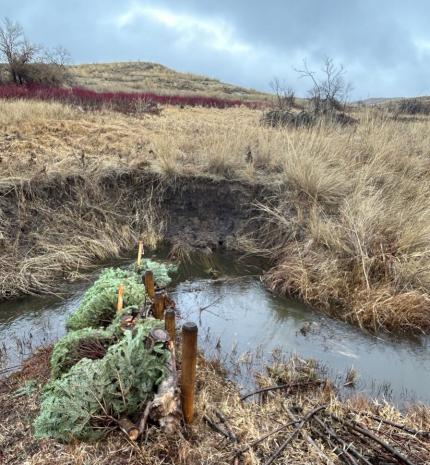Managing Wildlife Populations
Waterfowl: Biologist Clements attended the quarterly Washington Waterfowl Association Moses Lake Chapter meeting on Feb. 8. Clements gave a recap of the successful hen mallard nesting tube reconstruction project and offered another volunteer project of monitoring the tubes for any nesting activity starting in March.
Greater Sage-Grouse and Sharp-Tailed Grouse: Biologist Eilers mailed out letters to private landowners in Douglas County asking for land access permission to survey grouse on private property. Biologists will be searching for new greater sage-grouse and sharp-tailed grouse leks. They will monitor known leks across Douglas County to get population estimates of these species.
Douglas County currently has the greatest abundance of greater sage-grouse in the state of Washington. Unfortunately, populations are declining.
With the warmer temperatures and lack of snow this winter season, greater sage grouse are displaying at lek sites a few weeks early this year. Biologist Eilers and Hunter Education Coordinator Montanari completed the first lek counts in southern Douglas County near Alstown and the Badger Mountain area. The grouse lek near Badger Mountain has consistently been the most well-attended with up to 30 males displaying on some mornings in 2023, and it’s off to a good start this year with the highest count yet of 37 birds.



Sharp-Tailed Grouse Monitoring: Biologist Heinlen surveyed the winter habitats of sharp-tailed grouse (Tympanuchus phasianellus columbianus) finding a total of 28 birds foraging in the water birch (Betula occidentalis) trees in the Siwash Creek area. This is five more birds than were counted during the area’s spring lek surveys last year. It’s probable that there is at least one unknown lek in the area we have yet to document. Water birch catkins (seeds) are a primary food source for sharp-tailed grouse in the district making them an important component of sharp-tailed grouse habitat.

Mule Deer: Biologists Jeffreys and Eilers retrieved two GPS collars from mule deer to down-load data stored onboard. Between 2020 and 2022, more than 60 does were collared in Chelan County as part of an ungulate movement and migration study being conducted in several Washington herds as well as across the western United States.
Biologists have used location data gleaned from these GPS collars to learn valuable information about timing and duration of migration, migratory corridors, stopover points, and winter and summer range use for mule deer wintering in the Wenatchee Foothills as well as the Nahahum Canyon, Burch Mountain, and Swakane areas. These collars were programmed to drop off in four years after deployment, so the last 12 collared does still standing since the January 2020 capture dropped their collars as scheduled last month. Many are still inaccessible due to snow cover and land access, and biologists will continue to retrieve them over the upcoming months. Washington Department of Fish and Wildlife will continue to receive GPS data from the 13 active collars in Chelan County for two more years.



Pygmy Rabbit Winter Surveys: Staff members started out the year carrying out pygmy rabbit surveys in the Sagebrush Flat Wildlife Area. With a mowing and prescribed burn project on the horizon, they took advantage of the limited snow and conducted burrow surveys to inform staff members of the best areas for land management. While there have been no pygmy rabbit sightings in the project area, staff members have flushed several sage grouse and short-eared owls. Wildlife staff members will continue to work collaboratively with the pygmy rabbit recovery crew assisting with surveys outside of the project area.

Pygmy Rabbits: Biologist Clements led a group of Washington Conservation Corps members and the pygmy rabbit team members finish up burrow surveys on a parcel known to have active pygmy rabbit sites. The team successfully completed the remaining transects, and despite the lack of snow making burrows easier to identify and muddy terrain, they were able to identify multiple burrows and collect fecal samples to send off to the lab for genetic analysis.
Bobcat Research Assistance: Biologists Fitkin and Heinlen assisted Biologist Welfelt with a multi-day deployment of several dozen remote cameras as part of an ongoing research effort examining bobcat and lynx seasonal habitat use dynamics. Cameras were deployed from the valley floor on the Sinlahekin Wildlife Area to over 6500 feet on the divide between the Methow and Okanogan watersheds. Data collection will continue for another year, and in addition to bobcat and lynx, the cameras are gathering data on a variety of additional species of interest.
Additional thanks to retired Washington Department of Fish and Wildlife Biologist Base for helping with this effort.


Providing Recreation Opportunities
Water access staff members have been putting the newly acquired Bobcat mower arm to good use. Assistant Manager Steele, and Natural Resource Technicians Wilson and Blanchard have been able to mow previously hard to reach and access roadsides and tracks where traditional tractor mowing hasn’t been an option ahead of spring residual herbicide application. This was done at the Quincy Lakes Wildlife Area with both the Bobcat mower arm and the new Bobcat Mini Track 100 (MT 100). The mower and MT 100 were also used at the Lake Lenore fish trap for mechanical control of tall emergence vegetation. Steele and Blanchard also removed a fallen tree and repaired a damaged fence at Blue Lake in Grant County.





Conserving Natural Landscapes
West Foster Creek Beaver Dam Analogue Project: During late summer and early fall, wildlife area staff members installed around 50 beaver dam analogs on West Foster Creek near Bridgeport. These beaver dam analogs were revisited when staff members were alerted by Douglas County Public Utility Department Biologist Schilling that they had salvaged a large bounty of free Christmas trees. Wildlife area staff members repurposed 55 trees that were going to be discarded at Fred Meyer and another 60 from Home Depot.


Big Bend Restoration: When reflecting on accomplishments of the past year, staff members recall the all-hands-on deck effort to prepare seed, plant, and spray restoration fields at Big Bend in late fall. This work was across the Magers, Bissell Flat, and Back Rock Lake units. In total, staff members drill seeded 261 acres with native grass, 43 acres with native forbs, and planted 5-1/8-acre forb plug islands across another 30 acres. Each field was approached differently, with the most intensive restoration occurring at Back Rock. The Back Rock restoration fields required six staff members to work long hours mowing, harrowing, spraying, and drill seeding to complete the project before winter conditions took hold.

Other
Administrative Work: Biologists Dougherty and Clements attended the quarterly meeting with the Bureau of Reclamation to discuss updates within both agencies. Biologist Clements mentioned that she heard discussion of replacing panels within the canal near the Pinto Ridge Dam. She suggested that as parts are replaced, finding potential wildlife friendly options would be helpful to aid in deer that consistently end up stuck in that stretch of the canal.
Ground Squirrels: District staff members attended a meeting regarding the 2023 Washington ground squirrel survey efforts and to offer suggestions of future projects and next steps for this species.
Northern Leopard Frogs: District staff members began the process of selecting and interviewing candidates for scientific technician positions. When filled, these positions will assist in northern leopard frog recovery work. The new hires will be onboarded and ready to start the busy field season in April.
Shipping Container Improvements: The shipping container that is used to store seed for restoration fields has undergone significant improvements. Maintenance Mechanic Rios prepped the unit so that he could install a heater and air conditioning unit. This task ensures improved temperature control for seed and other materials stored in this unit.
Headquarters Reflooring: What was supposed to be a simple reflooring project at headquarters proved to be more exciting than anticipated. While peeling up the old flooring, Maintenance Mechanic Rios was surprised to find six gopher snakes deep in their hibernacula in a small space that had been created under the floor of an office space.
Assistant Manager Blake sought council from District Biologist Jeffreys and Fitkin who recommended she speak with Beck, a retired herpetologist and professor from Central Washington University. After seeking consultation, she decided to keep them contained in the correct environment to ensure they winter in the proper conditions.

